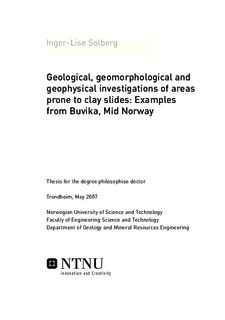| dc.description.abstract | Large areas prone to clay slides are present in Canada, Sweden and Norway. Traditionally, mainly geotechnical approaches have been used to solve clay-slide issues. However, there is great potential to utilise interdisciplinary studies in order to prevent or reduce possible slide damage. The present study combines geology, morphology and geophysical investigations, with geotechnical data. The purpose is to better understand landscape development, formation of quick clay and sliding in clay.
Thick, marine clay deposits in valleys along the Norwegian coast are occasionally subjected to large landslides involving quick clay. The development of quick clay is closely related to the deglaciation history of the coastal parts of Norway. During and after the last ice age, up to several hundred metres of glaciomarine and marine deposits accumulated in Norwegian fjords. These sediments were subsequently exposed on land due to glacioisostatic rebound. Leaching of salt from the marine clay by groundwater resulted in the development of quick-clay layers or pockets, which completely liquefy when remoulded.
The study area of this thesis is the small valley Buvika, located in the Trondheimsfjorden area, Mid Norway. Buvika is characterised by its undulating terrain with numerous slide scars and ravines. There are thick occurrences of quick clay in the subsurface.
The existing geotechnical and geophysical data, combined with sedimentology, structural geology, morphology, geophysical results, and 14C-datings, have given input to the understanding of the landscape development of the study area. From this, a deglaciation history has been deduced, indicating at least one, and possibly two, minor glacier re-advances in Late Allerød/Early Younger Dryas time. This implies that there have been more and larger ice-front oscillations in the study area than earlier documented.
The lowered relative sea level led to incision by rivers accompanied by numerous slides involving quick clay. The erosion pattern of a valley filled with glaciomarine and marine deposits can be quite complex, but careful analyses have helped outlining the interplay between river and ravine incision, groundwater erosion and sliding. The study of sediments and structures in large excavated sections have resulted in the detection of slide material from old flake-type slides, where only a thin layer of quick clay acted as a slide plane. Younger slide scars cutting into theses older slide deposits show further quick-clay development. Mapping of the morphology in Buvika has identified numerous slide scars and ravines. A relative chronology of slide events has been established based upon the slide scars’ position in the terrain and/or results from 14C-datings of terrestrial organic material. Most of the historical slide scars are located in the northern part of the valley.
Detailed mapping of the quick-clay extent is of great interest for planning and protection purposes, as the position of quick clay within slopes has a major impact on the landslide risk. In this study, the resistivity method is found to be potentially well suited for outlining quick-clay occurrences since quick clay has a slightly higher electrical resistivity (10-80 Ωm) than intact unleached clay (1-10 Ωm). This is due to a higher salt content in the latter. These relationships are supported by pore water salt content measurements. The resistivity profiles that were acquired show good correlation with other geophysical data and geotechnical drillings. However, the resistivity method must be combined with other investigations, since both leached, non-quick clay and silty, non-sensitive material may give resistivity values of the same range as quick clay.
The stratigraphy of an area strongly influences the landscape development. It determines the morphology, such as ravine development, and size, shape and distribution of slides. To the east of Buvika, thick and frequent layers of sand and gravel in the dominant clay deposits drain the slopes, leading to development of deeply incising ravines. To the south and north, thinner layers of coarse material in the clay lead to pore-pressure build-ups and quick-clay development, resulting in numerous slide scars. | nb_NO |
